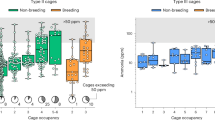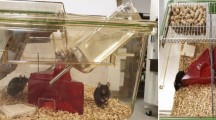Abstract
The 2011 edition of the Guide for the Care and Use of Laboratory Animals includes new recommendations for the amount of floor space that should be provided to breeding mice. When pairs or trios of continuously breeding mice are housed in shoebox cages, they may have less than this recommended amount of floor space. High housing densities may adversely affect animal health, for example, by compromising air quality inside the cage. Hence, some institutions are carefully reevaluating the microenvironments of breeding cages. The use of individually ventilated cages (IVCs) to house research mice allows for greater control over the quality of the cage microenvironment. The authors evaluated the microenvironments of shoebox cages in an IVC rack system housing breeding and non-breeding Swiss Webster mice. Ammonia concentrations were significantly higher in cages housing breeding trios with two litters. Histopathologic lesions attributable to inhaled irritants such as ammonia were found in mice housed in breeding pairs and trios. The authors conclude that the microenvironments of cages in an IVC rack system housing breeding pairs and trios may be detrimental to animal health.
This is a preview of subscription content, access via your institution
Access options
Subscribe to this journal
We are sorry, but there is no personal subscription option available for your country.
Buy this article
- Purchase on Springer Link
- Instant access to full article PDF
Prices may be subject to local taxes which are calculated during checkout



Similar content being viewed by others
References
Institute for Laboratory Animal Research. Guide for the Care and Use of Laboratory Animals 7th edn. (National Academies Press, Washington, DC, 1996).
Institute for Laboratory Animal Research. Guide for the Care and Use of Laboratory Animals 8th edn. (National Academies Press, Washington, DC, 2011).
Davidson, L.P., Chedester, A.L. & Cole, M.N. Effects of cage density on behavior in young adult mice. Comp. Med. 57, 355–359 (2007).
Eveleigh, J.R. Murine cage density: cage ammonia levels during the reproductive performance of an inbred strain and two outbred stocks of monogamous breeding pairs of mice. Lab. Anim. 27, 156–160 (1993).
Laber, K., Veatch, L.M., Lopez, M.F., Mulligan, J.K. & Lathers, D.M. Effects of housing density on weight gain, immune function, behavior, and plasma corticosterone concentrations in BALB/c and C57BL/6 mice. J. Am. Assoc. Lab. Anim. Sci. 47, 16–23 (2008).
Nicholson, A. et al. The response of C57BL/6J and BALB/cJ mice to increased housing density. J. Am. Assoc. Lab. Anim. Sci. 48, 740–753 (2009).
Smith, A.L., Mabus, S.L., Stockwell, J.D. & Muir, C. Effects of housing density and cage floor space on C57BL/6J mice. Comp. Med. 54, 656–663 (2004).
Smith, A.L., Mabus, S.L., Muir, C. & Woo, Y. Effects of housing density and cage floor space on three strains of young adult inbred mice. Comp. Med. 55, 368–376 (2005).
O'Malley, J., Dambrosia, J.M. & Davis, J.A. Effect of housing density on reproductive parameters and corticosterone levels in nursing mice. J. Am. Assoc. Lab. Anim. Sci. 47, 9–15 (2008).
Reeb-Whitaker, C.K. et al. The impact of reduced frequency of cage changes on the health of mice housed in ventilated cages. Lab. Anim. 35, 58–73 (2001).
Lipman, N.S., Corning, B.F. & Coiro, M.A. Sr. The effects of intracage ventilation on microenvironmental conditions in filter-top cages. Lab. Anim. 26, 206–210 (1992).
Lipman, N.S. Isolator rodent caging systems (state of the art): a critical view. Contemp. Top. Lab. Anim. Sci. 38, 9–17 (1999).
Höglund, A.U. & Renström, A. Evaluation of individually ventilated cage systems for laboratory rodents: cage environment and animal health aspects. Lab. Anim. 35, 51–57 (2001).
Reeb, C. et al. Microenvironment in ventilated animal cages with differing ventilation rates, mice populations, and frequency of bedding changes. Contemp. Top. Lab. Anim. Sci. 37, 43–49 (1998).
Gamble, M.R. & Clough, G. Ammonia build-up in animal boxes and its effect on rat tracheal epithelium. Lab. Anim. 10, 93–104 (1976).
Krohn, T.C. & Hansen, A.K. The effects of and tolerance for carbon dioxide in relation to recent developments in laboratory animal housing. Scand. J. Lab. Anim. Sci. 27, 173–181 (2000).
Burn, C.C., Peters, A., Day, M.J. & Mason, G.J. Long-term effects of cage-cleaning frequency and bedding type on laboratory rat health, welfare, and handleability: a cross-laboratory study. Lab. Anim. 40, 353–370 (2006).
Hasenau, J.J., Baggs, R.B. & Kraus, A.L. Microenvironments in microisolation cages using BALB/c and CD-1 mice. Contemp. Top. Lab Anim. Sci. 32, 11–16 (1993).
Perkins, S.E. & Lipman, N.S. Characterization and quantification of microenvironmental contaminants in isolator cages with a variety of contact beddings. Contemp. Top. Lab. Anim. Sci. 34, 93–98 (1995).
Perkins, S.E. & Lipman, N.S. Evaluation of microenvironmental conditions and noise generation in three individually ventilated rodent caging systems and static isolator cages. Contemp. Top. Lab. Anim. Sci. 35, 61–65 (1996).
Rosenbaum, M.D., VandeWoude, S. & Johnson, T.E. Effects of cage-change frequency and bedding volume on mice and their microenvironment. J. Am. Assoc. Lab. Anim. Sci. 48, 763–773 (2009).
Silverman, J., Bays, D.W., Cooper, S.F. & Baker, S.P. Ammonia and carbon dioxide concentrations in disposable and reusable ventilated mouse cages. J. Am. Assoc. Lab. Anim. Sci. 47, 57–62 (2008).
Silverman, J., Bays, D.W. & Baker, S.P. Ammonia and carbon dioxide concentrations in disposable and reusable static mouse cages. Lab Anim. (NY) 38, 16–23 (2009).
Serrano, L.J. Carbon dioxide and ammonia in mouse cages: effect of cage covers, population, and activity. Lab. Anim. Sci. 21, 75–85 (1971).
Greiner, T. Indoor air quality: carbon monoxide and carbon dioxide. Department of Agricultural and Biosystems Engineering, Iowa State University. (1995). http://www3.abe.iastate.edu/human_house/aen125.asp.
Broderson, J.R., Lindsey, J.R. & Crawford, J.E. The role of environmental ammonia in respiratory mycoplasmosis of rats. Am. J. Pathol. 85, 115–128 (1976).
Green, A.R., Wathes, C.M., Demmers, T.G., Clark, J.M. & Xin, H. Development and application of a novel environmental preference chamber for assessing responses of laboratory mice to atmospheric ammonia. J. Am. Assoc. Lab. Anim. Sci. 47, 49–56 (2008).
Godbey, T., Gray, G. & Jeffery, D. Cage-change interval preference in mice. Lab Anim. (NY) 40, 225–230 (2011).
Buckley, L.A., Jiang, X.Z., James, R.A., Morgan, K.T. & Barrow, C.S. Respiratory tract lesions induced by sensory irritants at the RD50 concentration. Toxicol. Appl. Pharmacol. 74, 417–429 (1984).
Tepper, J.S., Weiss, B. & Wood, R.W. Alterations in behavior produced by inhaled ozone or ammonia. Fundam. Appl. Toxicol. 5, 1110–1118 (1985).
Schaerdel, A.D., White, W.J., Lang, C.M., Dvorchik, B.H. & Bohner, K. Localized and systemic effects of environmental ammonia in rats. Lab. Anim. Sci. 33, 40–45 (1983).
Danneman, P.J., Stein, S. & Walshaw, S.O. Humane and practical implications of using carbon dioxide mixed with oxygen for anesthesia or euthanasia of rats. Lab Anim. Sci. 47, 376–385 (1997).
Feldman, D.B. & Gupta, B.N. Histopathologic changes in laboratory animals resulting from various methods of euthanasia. Lab Anim. Sci. 26, 218–221 (1976).
Burkholder, T.H. et al. Comparison of carbon dioxide and argon euthanasia: effects on behavior, heart rate, and respiratory lesions in rats. J. Am. Assoc. Lab. Anim. Sci. 49, 448–453 (2010).
Office of Laboratory Animal Welfare. Frequently Asked Questions: May the IACUC approve deviations from the Guide for rodent (mice and rats) cage density? PHS Policy on Humane Care and Use of Laboratory Animals. http://grants.nih.gov/grants/olaw/faqs.htm#f10.
Jacoby, R.O., Fox, J.G. & Davisson, M. in Laboratory Animal Medicine 2nd edn. (eds. Fox, J.G., Anderson, L.C., Loew, F.M. & Quimby, F.W.) 35–120 (Academic, New York, 2002).
Ryu, J., Heldt, G.P., Nguyen, M., Gavrialov, O. & Haddad, G.G. Chronic hypercapnia alters lung matrix composition in mouse pups. J. Appl. Physiol. 109, 203–210 (2010).
Nielson, G.D., Petersen, S.H., Vinggaard, A.M., Hansen, L.F. & Wolkoff, P. Ventilation, CO2 production, and CO2 exposure effects in conscious, restrained CF-1 mice. Pharmacol. Toxicol. 72, 163–168 (1993).
Gaafar, H., Girgis, R., Hussein, M. & el-Nemr, F. The effect of ammonia on the respiratory nasal mucosa of mice. A histological and histochemical study. Acta Otolaryngol. 112, 339–342 (1992).
Harkema, J.R. Comparative aspects of nasal airway anatomy: relevance to inhalation toxicology. Toxicol. Pathol. 19, 321–336 (1991).
McInnes, E.F. & Miller, R.A. A review of upper respiratory tract inhalation pathology. Comp. Clin. Pathol. 16, 215–222 (2007).
Acknowledgements
This study was funded by the Animal Resource at the University of Rochester. We thank Dan DeMagistris and April Tirabassi for their assistance in experimental set-up and MaryKay Austin, Linda Johnstone and Michelle Streamer for their technical skill and expertise.
Author information
Authors and Affiliations
Corresponding author
Ethics declarations
Competing interests
The authors declare no competing financial interests.
Rights and permissions
About this article
Cite this article
DiVincenti, L., Moorman-White, D., Bavlov, N. et al. Effects of housing density on nasal pathology of breeding mice housed in individually ventilated cages. Lab Anim 41, 68–76 (2012). https://doi.org/10.1038/laban0312-68
Received:
Accepted:
Issue Date:
DOI: https://doi.org/10.1038/laban0312-68



